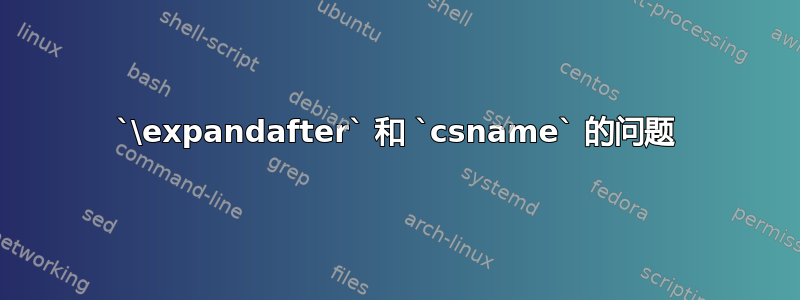
上面有一段代码,我想进一步分解。我想以与特殊宏类似的方式定义这两个宏\exercice和,但目前我失败了。我遗漏了和的一些东西……\topic\@init@new@exo\expandaftercsname
\documentclass[12pt]{article}
\usepackage{pgfkeys}
\makeatletter
\newcommand\@init@new@exo[1]{
\pgfkeys{
/#1@keys/.is family,
/#1@keys,
pts/.initial = {}, % Render the subject or not
src/.initial = {} % Number of the exam
}
\expandafter\newcommand\csname #1@number\endcsname{Nb for #1}
}
\@init@new@exo{topic}
\@init@new@exo{exercice}
\newcommand\exercice[1][]{%
\begingroup
\pgfkeys{/exercice@keys, #1}
\pgfkeysgetvalue{/exercice@keys/pts}{\exercice@points}
\pgfkeysgetvalue{/exercice@keys/src}{\exercice@source}
exercice \exercice@number{}
(\exercice@points{} pts)
[Source :\exercice@source{}]
\endgroup
}
\newcommand\topic[1][]{%
\begingroup
\pgfkeys{/topic@keys, #1}
\pgfkeysgetvalue{/topic@keys/pts}{\topic@points}
\pgfkeysgetvalue{/topic@keys/src}{\topic@source}
topic \topic@number{}
(\topic@points{} pts)
[Source :\topic@source{}]
\endgroup
}
\makeatother
\begin{document}
\exercice[pts = 1, src = Imaginaire]
\exercice
\topic[pts = 1, src = Imaginaire]
\topic[pts = 2]
\end{document}
答案1
类似这样的操作会安排所有 csname 构造首先发生,因此它不会与 pgf 解析混合。
\documentclass[12pt]{article}
\usepackage{pgfkeys}
\makeatletter
\newcommand\@init@new@exo[1]{%%
\pgfkeys{
/#1@keys/.is family,
/#1@keys,
pts/.initial = {}, % Render the subject or not
src/.initial = {} % Number of the exam
}%%
%%
\expandafter\newcommand\csname #1@number\endcsname{Nb for #1}%%
}
\@init@new@exo{topic}
\@init@new@exo{exercice}
\newcommand\zz[1]{\expandafter\@zz
\csname#1\expandafter\endcsname
\csname#1@points\expandafter\endcsname
\csname#1@source\expandafter\endcsname
\csname#1@number\endcsname
{#1}}
\newcommand\@zz[5]{%
\newcommand#1[1][]{%
\begingroup
\pgfkeys{/#5@keys, ##1}%%
\pgfkeysgetvalue{/#5@keys/pts}{#2}%%
\pgfkeysgetvalue{/#5@keys/src}{#3}%%
#5 #4{} %%
(#2{} pts)
[Source :#3{}] %%
\endgroup
}%%
}
\zz{exercice}
\zz{topic}
\makeatother
\begin{document}
\exercice[pts = 1, src = Imaginaire]
\exercice
\topic[pts = 1, src = Imaginaire]
\topic[pts = 2]
\end{document}
答案2
您可以在“init”阶段包含命令的定义:
\documentclass[12pt]{article}
\usepackage{xparse,chngcntr}
\ExplSyntaxOn
\NewDocumentCommand{\initkeys}{mo}
{
\newcounter{#1}
\IfValueT{#2} { \counterwithin{#1}{#2} }
\projetmbc_init_keys:n { #1 }
}
\cs_new_protected:Nn \projetmbc_init_keys:n
{
\keys_define:nn { projetmbc/#1 }
{
pts .tl_set:c = l_projetmbc_#1_pts_tl,
src .tl_set:c = l_projetmbc_#1_src_tl,
}
\exp_args:Nc \NewDocumentCommand {#1} { O{} }
{
\refstepcounter{#1}
\group_begin:
\keys_set:nn { projetmbc/#1 } { ##1 }
#1 ~ \use:c { the#1 } ~
\tl_if_empty:cF { l_projetmbc_#1_pts_tl }
{
\c_space_tl
( \tl_use:c { l_projetmbc_#1_pts_tl } ~ pts)
}
\tl_if_empty:cF { l_projetmbc_#1_src_tl }
{
\c_space_tl
[Source: ~ \tl_use:c { l_projetmbc_#1_src_tl } ]
}
\group_end:
}
}
\ExplSyntaxOff
\initkeys{exercice}
\initkeys{topic}[exercice]
\begin{document}
\exercice[pts = 1, src = Imaginaire]
\exercice
\topic[pts = 1, src = Imaginaire]
\topic[pts = 2]
\end{document}



